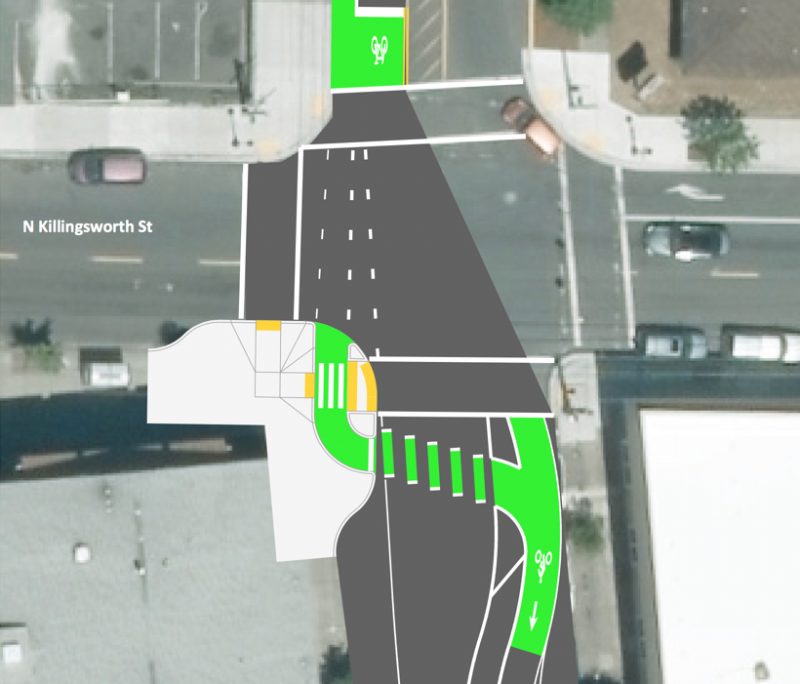
After presenting a slew of options for improving safety and traffic flow on North Vancouver at Cook back in June, the Portland Bureau of Transportation has settled on an option they like.

(Graphic: PBOT)
The plan, as presented to the Bicycle Advisory Committee (BAC) last night, calls for moving the bikeway to the left side of the street from North Killingsworth to North Stanton (a distance of 1.3 miles). The project would also widen the Vancouver bikeway with a buffer zone.
PBOT Bicycle Program Manager Roger Geller presented the idea. He said the left-side bikeway option scored the highest in an internal decision-making process (below) because it improves cycling comfort by eliminating right-turn conflicts with bus and car operators, while at the same time it won’t delay transit. (Fun fact: As you can see in the ranking matrix, delay to auto users was given less weight than other factors. Yeah!)
The other option PBOT analyzed further since June was a dedicated signal phase for bicycle riders at Cook. This would have (similar to the bike signal at westbound Broadway and Williams) separated the movements of southbound bicycle riders and right-turning auto users. While this had a high safety ranking because it would eliminate conflicts, the option wasn’t moved forward because it would add considerable time delays to all users (something that happens when a new phase is added to an existing signal) and it would cause congestion that would likely spill over to Fremont one block over.
It’s worth noting that Vancouver is an “enhanced transit corridor” and TriMet has been looking over PBOT’s shoulders to make sure nothing is done that would slow down their buses here.

To make the left-side bikeway work, PBOT needs to get riders from the right (where the bike lane is north of Killingsworth) to the left, and back again in time for people to make the turn onto Russell for the Flint Avenue/Broadway Bridge connection. “To do a facility like this,” Geller said, “It’s really all about the transitions.”
Advertisement
As you can see in the preliminary drawings below, PBOT will begin the switch to the left side at Killingsworth. The plan is for a new bike box that will allow southbound bicycle riders to get in front of auto users during a red light at Killingsworth (not sure if PBOT realizes that many people don’t feel comfortable staging in front of cars in these boxes during red lights). With a head-start into the intersection, bicycle users would merge to the left to enter the new bikeway. On a green signal phase, bicycle riders would stay on the right across Killingsworth and then take advantage of a newly painted green lane and crossbike to merge over to the bikeway.
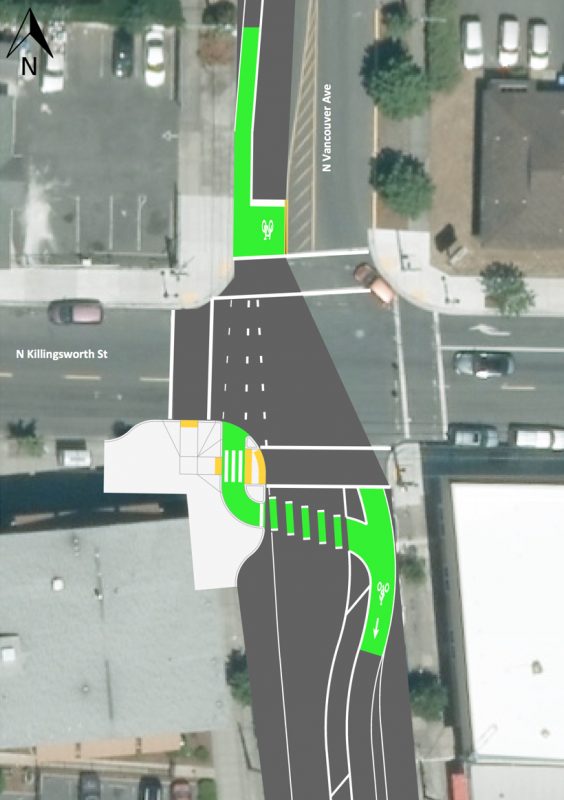
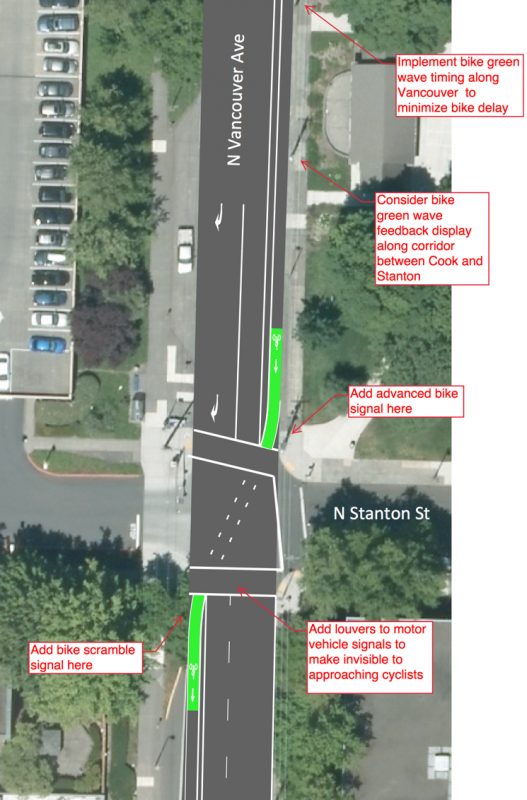
At North Stanton (adjacent to Legacy Emanuel Hospital and Dawson Park) PBOT would add a new bicycle signal to facilitate crossing back over to the right side. Geller said signal timing would be adjusted between Cook and Stanton to prioritize bicycling, giving riders a “green wave” effect. The signals would be timed for 14 mph.
A BAC member suggested painting green stripes across the Stanton intersection to improve safety.
One issue with a left-side bikeway on Vancouver is the driveway into the New Seasons Market parking lot between Fremont and Cook. A PBOT engineer at the meeting last night said their counts found only 70 people turn left out onto Vancouver from the parking lot during the AM peak period. “Not a huge number,” she said.
PBOT estimates the cost of this project at $200,000. Asked by a BAC member last night whether any physical protection would be added to the buffer zones, a PBOT engineer said, “We could look into that. Right now we have funding for just the painted buffer.”
The BAC endorsed this design last night. PBOT will likely make a few final tweaks before doing some public outreach and scheduling the construction. I don’t know the exact timeline yet but will update this post when I find out.
Do you ride on Vancouver? What do you think of these new plans?
— Jonathan Maus: (503) 706-8804, @jonathan_maus on Twitter and jonathan@bikeportland.org
Never miss a story. Sign-up for the daily BP Headlines email.
BikePortland needs your support.

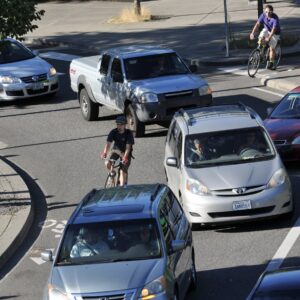
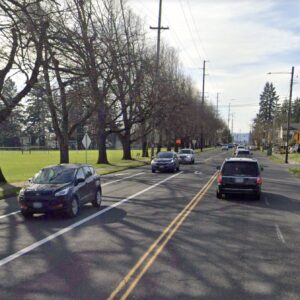
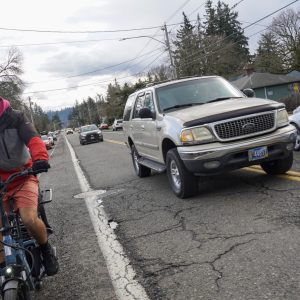
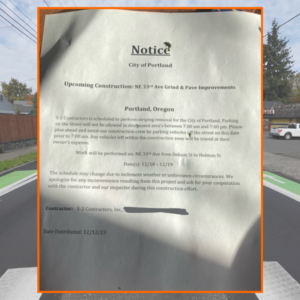
Thanks for reading.
BikePortland has served this community with independent community journalism since 2005. We rely on subscriptions from readers like you to survive. Your financial support is vital in keeping this valuable resource alive and well.
Please subscribe today to strengthen and expand our work.
A true Vision Zero design would prioritize walking and biking with a physically separated bike lane and physically separated intersections. This would require removing parking, particularly for floating bus stops.
Why is the auto lane mouth so wide just south of the Killingsworth intersection?
It’s currently two vehicle lanes.
If that driveway is used so infrequently why not remove it entirely and have just one driveway for the lot that doesn’t cross a bike lane?
The driveway on the other side does cross the bike lane. It’s a nightmare.
I Ride this chunk of Vancouver at least twice a day. The problem with the scramble is that Stanton is a low use street that really only feeds in to the Emanuel Parking lot so the light is usually green on Vancouver, so 90% of the time I can ride right through this section. In the scramble, from what I can tell, bikes will stack up in the box on the left waiting for the louvered light to let them cross Vancouver diagonaly. This will be time consuming and add danger because many will just merge in to the auto lane and then merge to the right hand lane once Stanton has been crossed. Many of the people driving down Stanton heading towards Emanuel are not regular urban drivers and seem confused when interacting with a regular bike lane , let alone a diagonal scramble.
I’d definitely take the lane also and avoid the wait for the scramble.
Why no bike signal at the Killingsworth intersection? That seems like a dangerous intersection to be crossing across car traffic!
That was my first thought. Seems it needs a bike-only phase to allow a queue to pass and to allow those who don’t want to changes lames through the intersection to cross without autos.
I have ridden down Vancouver year-round almost every morning on my commutes. I’m not sure why this action is necessary unless the fact that it scares people is reason enough. I have only ever witnessed one car-bicycle accident on Vancouver and that was a typical right-hook on Fremont.
I’ve seen a bike-car collision at this intersection at least once
The Emergency Room zone is worse for right hooks IMO and they’re conveniently switching back to right side just before that intersection.
“Crossbikes” are not just legally ambiguous – they’re legally meaningless. They’re just suggestions, few drivers know what they’re supposed to suggest, and those who are that well educated seem to know that the marking has no legal meaning.
When crosswalks were first introduced they were also legally ambiguous. If we desire people driving to stop for people biking at important bike network intersections then crossbikes have a role to play.
I also dispute the contention that crossbikes are not legally ambiguous. For example, the crossbikes at SE Salmon and 20th are legal crosswalks according to my read of ODOT and FHWA definitions.
Edit fail: “I also dispute the contention that all crossbikes are legally ambiguous.”
FUBAR. Take Rodney.
Even Rodney does that ride jog left, jog right, go forward, move ahead do the hokey pokey thing.
It’s as bad as Concord or Holman
Switching from right to left from the bike box when the signal changes seems reasonably doable; though hardly good for the whole 8-80 demographic it’s at least as good as the current conflict scenario.
However, going through during a green then making a sharp left across the auto lanes won’t ever be done at speed even by an experienced rider. And since “crossbikes” are legally meaningless (anyone in the lane has right of way, so crossbike users must always yield to them) there’s nothing there to take advantage of. That looks frighteningly bad and likely to be a new conflict area.
In sum I don’t see much improvement here that’s worth the cost. I get that there’s a problem and that we need to be creative to fix it, but following the green path as drawn here doesn’t look better.
Agree, that’s a really bizarre treatment to me. Yes, you’re ahead of the vehicles in the box but by the time you enter the intersection then weave right to angle yourself to move across all the lanes, you’ll be faced with a stream of cars to wait out. I’m not sure why you wouldn’t wait in the green box on the far left and just proceed through the intersection to left-side bike lane except that you’ve got another through lane. The only good thing is that I don’t think there is often that much of a queue of southbound cars on vancouver at the killingsworth light when i ride it.
To me it would make a lot more sense to have the green box treatment at Alberta, where you could wait in the left side of the box, get the head start and proceed across the intersection to the lane. At that spot the left lane is a forced left so you’d just ride straight ahead and pick up the lane on the other side of Alberta.
For $200,000 PBOT could:
1. Purchase approximately 300+ bollards and paint
2. Remove the West parking lane
3. Place 3-4 floating bus stops
4. Restripe separated intersections/bike lanes
5. Place bollards to separate the entire route
This would be a simpler, more predictable design that prioritizes walking/biking/transit. Unfortunately, this list does not include political leadership.
Feels like they’re replacing one mixing zone with two mixing zones. Am I the only one thinking that?
I ride Vancouver/Williams daily and have to say I love it above any other commute I’ve had in nearly 20 years in Portland. I love catching a tailwind and riding the green wave all the way in – it’s direct, intuitive and feels prioritized. Adding two idiosyncratic crossovers could be harsh if done badly.
The Cook mixing zone is unpleasant but doable. Wouldn’t be an issue if they closed the 405 on/off ramp! 🙂
Agree with you, I ride it everyday and it’s definitely the least stressful segment in my commute. The cook zone is the only stressful part, and to be honest, it’s more because other bikes are often unpredictable (you never know when folks will brake suddenly because they aren’t sure if they should yield to the car, or ride straight and let the car yield to them, etc.). As a sidenote, I totally get why bike riders are nervous and brake suddenly in this section and don’t blame them…though I find that if you ride straight on predictably at regular speed the cars pretty much know they have to wait for the gap.If they wanted to do anything to help with that Cook mixing zone, I’d give the cyclists a healthy leading green signal to get the group moving and clearing the mixing zone before releasing the cars to head south to the exit ramp.
Anyway… what I’m sayin’ is, I agree that in my humble experience Vancouver actually works pretty well – though i notice some cyclist discomfort at that section.
>>redacted<>redacted<>redacted<>redacted<>redacted<>redacted<>redacted<< Interstate next?
Painting crossbikes without supporting infrastructure to keep people safe is so… ?. This change, without a bicycle signal, literally guides people riding bikes directly into car traffic — like a coordinated collision. Thanks, PBOT! Fresh forward-thinking ideas FTW.
“scored the highest in an internal decision-making process.”
This “improvement” is just PBOT making out with itself.
I swear to god I’m going to start driving.
Oliver, things are not that bad. No need to sell your soul and go to the dark side.
From what I see, a large number of folks turn onto Vancouver at Going, so their left turn will be much less stressful. So there’s that.
From my experience the ride down Vancouver from Killingsworth to Russell is problem free, even the mixing at the 405 ramp is not a problem except for the morning rush hour. This will create a much more complicated and dangerous bike journey to alleviate a problem that occurs for an hour of so each day. Even the problem during morning rush is not that scary because the cars are jammed up and going slowly so the mix is chaotic, but rarely life threatening. I would rather see bollards and a shorter mix zone than these changes.
It really isn’t that bad…and I agree…some bollards to limit the cross over area would be ideal. In that area, if traffic is really bad, I just go a little slower.
Maybe PDOT should spend some time driving this route during rush hour and to get a better appreciation for the cyclist’s experience. They seem to be lacking that. Can you imagine the hilarity that would ensue if they proposed this treatment for cars?
Maybe they should spend some time cycling this route before they decide. Unless bikes are given their own green light phase, I don’t see the proposed Killingworth intersection working safely.
“highest in an internal decision-making process”
Well I’m glad that PBOT employees will be happy.
I guess bus conflicts will be better. But from my experience on Vancouver, they’re switching us back to the right side one block too soon, putting us back in the right hook zone just in time for preoccupied drivers turning right to get to the emergency room.
For the most part this will simply swap right hooks for left hooks.
Why of why does PBOT insist on making simple things so complicated. (I’m looking at you, you utterly useless and unused greenway across SE Stark at SE 30th)
That N Vancouver & N Killingsworth intersection is just PBOT’s friendly reminder that we’re second class road users.
Terrible, terrible, terrible. Seriously. Something is broken at PBOT.
The funny thing is, PBOT won’t take the blame for this. We will.
That’s one of the reasons I hate stuff like this. It complicates everyone’s life, but drivers hate on us because they assume we love it and demanded it. There are many examples of this around town.
Crossing Killingsworth, the green signal phase appears to ask bike users to queue on the south side and wait for a signal change to cross the auto lane.
Is this design compatible with the expected volume of bike traffic associated with our mode share goals over the lifetime of this design? That queue zone seems rather small.
1. West lane of Vancouver from Fremont to Cook: Protected bike lane with floating bus stop. Cook bike light that alternates 1/3 with Vancouver and Cook car lights.
2. Middle lane: Right turn only. No turn on red.
3. East lane: Right, left or straight.
Cars zipper merge on Cook or expand 405 on-ramp entrance to allow both Cook lanes to turn onto on-ramp.
This would also couple bikes and pedestrians.
It appears that only one or two bikes could fit in the queue zone without blocking the pedestrian crosswalk. What are other cyclists expected to do during a green light? Pile up in the bike lane, or fill in the bike box and block car traffic?
Anyone who has ever queued up for the turn onto the eastward-bound Tilikum Crossing path can imagine what a mess this is going to be in practice.
Put the bike lane to the right of the turn lane onto Cook just like at Broadway and Williams.
The design above has an advance bike signal. If you’re going to have special signalization for bikes then get rid of the side switching crossover and put a bikes only signal at Cook. The side switch is superfluous.
There’s something in the green chart above that suggests this solution is going to take longer, but by how much? I can’t say I get the advantages of moving bikes to the left and then back again.
Why does PBOT keep doing this? They make a convoluted, impractical route for bicycles, then wonder afterward why no one likes it. Look at the Tillikum bridge route. It’s the same thing six times over.
Agreed. Any time saved for bikes at Cook will likely be lost switching back at Stanton. More conflicts, less predictability, less safety.
It appears that PBOT has a comprehensive priority when it comes to creating new bike infra: slow down bikes, add stops for bikes, add difficult, non-intuitive sharp turns, install bollards to increase the severity of sharp turns and further complicate maneuvers in congested areas (also they become surprising obstacles at night), funnel cyclists into narrow chutes and pinch points (fail to remove or add new existing posts, signs and obstructions), create new infra which is difficult to clean and maintain, and always, always, always give priority to buses and promote bike/bus conflicts. All this done on a shoe-string budget that comes nowhere close to the spending amount suggested by current (and future) bike mode share.
I hate this.
Ride this daily. Good grief, makes very little sense; if it ain’t broke, don’t fixit. $200,000 – what a boondoggle!
This is a well intentioned move by PBOT to improve the Vancouver bikeway, however this design feels horrifyingly worse than what’s on the ground now. I think we have learned through the Williams ave design that left-running bike lanes are counterintuitive to most road users, to apply this design to only one segment is even more confusing. In fact, during the Williams process we were told “once you go left, you can’t go back” by PBOT staff.
I have ridden this segment over a thousand times and this will make things decidedly worse for cyclists. Two thumbs down from me.
Also, didn’t they just install that median island on the right side of Vancouver just north of Stanton *twice* a year or so ago?
That was my first thought too about the enhanced crosswalk there and how this seems to eliminate it.
PBOT is making these changes to support the City’s redevelopment proposal for the new “Amazon District” and the local arterial traffic it will generate…car traffic that needs less congestion created by bikes. (“Amazon” staff will not be cycling to work.)
Gotta fill those still vacant 1960s redevelopment blocks near the hospital – in someone’s lifetime!..
My $.02 from Eugene is that the left side bike lanes work pretty well here. My primary commute is along a curbtight left lane on a one way. The bike box where High St transitions from left to right works well with the signal timing. Some of the other mixing zones with left lanes are much successful.
You may be the only person in Eugene who thinks that mess at the north end of High St is functional. Actually, none of the left-side bike lanes in Eugene work for anyone I know who rides, admittedly a smaller number of people every year as we continue our downward trend, having now lost 43% of our cyclists since 2009.
I rode Vancouver into downtown for years and compared to that High St and its transition on 7th is a huge improvement. Especially since they tore down city hall. Don’t get me wrong, the two way cycletrack is the way to go. Portland is like five to ten years behind Eugene so even this halfway measure could be an improvement.
I rode Pearl and High Streets for years and thought that worked. Providing a transition are of more than two blocks to move to the other side allowed the cyclist to pick a good time and place.
WOW, just…WOW.
Never in all my years of riding this street have I thought “this needs to be reinvented”
It’s like the people at PBoT just sit around all day trying to find more low hanging fruit to eat. Like their very lives depend on it. Just more convoluted painting projects designed around some imagined timid and enfeebled rider and bound to cause all matter of confusion to all involved.
This.
One thing that holds things progress back is we keep scrеwing around with bike infrastructure that works reasonably well while neglecting areas that have none. If they’ve got some spare paint and need something to do with it, I personally wouldn’t mind some on Lombard in the areas that have no bike lane whatsoever.
Though in the spirit of the recent article calling out racism in infrastructure, I would be happy to hear that the resources were used to improve underserved areas.
Absolutely! If PBOT is willing to improve the bike network in North Portland and has $200,000 and some paint, please leave Vancouver alone and complete the bike lanes along Skidmore between Michigan and 7th! We NEED safe, controlled intersections at arterials and a direct connection over 1-5 between MLK and Interstate.
“around some imagined timid and enfeebled rider”
this infrastructure does little to encourage timid riders to cycle so your comment is demeaning, elitist, and untrue.
Roger, is this really 8-80? Honestly?
My thoughts exactly.
So, if I’m bicycling southbound on Vancouver crossing Killingsworth, do I have two options for the right side to left side transition?
Option 1. Take the lane and make my transition to the left side bike lane while going through the intersection.
Option 2. Use the bike lane to go to the southwest corner of the intersection and then use the crossbike to transition across the south leg of the intersection to get to the left side bike lane.
Now some questions:
With Option 1, would I be running afoul of the law that requires me to use the bike lane leading me to the SW corner? The exceptions are to avoid hazards or to make a left turn. I’m not making a left turn, so I guess I’d have to rely on the hazard defense.
With Option 2, am I expected to wait on the SW corner for the green for eastbound Killingsworth traffic? Or do I use the crossbike to make the transition whenever I choose? Who has the right of way in this situation? The southbound motorist? The bicyclist because he/she is approaching from the right? Does the crossbike have any legality here? Does it imply right of way?
Confusion is never your friend and this design features it in spades!
If a design relies upon correct interpretation of pavement markings, the design is a failure.
QFT
I would extend that to include people needing to read a bunch of tiny signs.
Pavement markings are totally invisible under a wide variety of conditions. Reading signs in the dark and rain on busy roads with oncoming headlights is equally fun, even if your own are quite good.
I hate the Cook intersection now. Riding it with a kid in a Burley is really scary for me. I mostly use Rodney now, like many other folks on here.
But, because of that fear factor, I sort of like the idea of a flip-flop, but the mixing at Killingsworth does seem particularly confusing. And the intersection looks like another special, unique treatment–which is the opposite of the Vision Zero mantra about predictability, right?
Jonathan, was there any discussion of using the parking on the E side of the street to create a sort-of-buffered bike lane like in the Lloyd? I don’t love how it works, but I’ve come to accept that it’s probably more appealing than paint, especially for a wider range of cyclists.
The decision matrix is utter nonsense. It assume the same cardinal ranking (3 is three times better than 1) for all criteria when difference between the options might be very different by criteria. It also gives every criteria the same weight, e.g., safety has the same weight as delay for people driving cars. Vision Zero, anyone? I also find it ironic that they ranked this options highest for cyclist comfort when I see 40+ negative comments here from, well, people riding bikes.
I understand the need to rank alternatives but there are better ways to do that. The ranking should reflect PBOT’s official goals, such as Vision Zero or the 25 percent bike share goal. One way to that is to score alternatives depending on how strongly they support these goals.
Good points, but I see a weighting of “1” for motorist delay and “1.5” for safety.
But you raise a good question: where did these weights come from? Even 1.5:1 for preservation of life vs motorist delay seems to be wrong if it was based on Vision Zero principles.
If you adjust “cyclist comfort” down 2 points for the left side, the proposed solution only scores 17.5. Looks to me like they cooked the numbers to get the answer they wanted to greenwash a cars-first project. We’re also adding delay for bikes while removing it for bus and cars. We need to add convenience *and* safety for biking, quit worrying about keeping drivers happy (when fuel taxes start paying the cars’ fair share for road upkeep, we could start to consider building something for driver convenience.) This whole project is just about trying to get bikes “out of the way”, and will be a net loss in safety with falling ridership.
Despite the weighting, the most important numbers on that grid are the 1 for transit delay and 1 for motorist delay for the protected signal. The rest of the grid was filled out with these numbers in mind. I wouldn’t be surprised if this was actually “perceived delay” rather than an actual delay.
+10 this
I think this project will dramatically reduce the number of right-hooks. Unfortunately, I believe this will happen by discouraging people from riding so that there are fewer right-hook targets.
Interstate, with all its flaws, just keeps looking better and better.
I personally don’t understand why people don’t like Interstate. There are a couple minor issues along it, but overall there are fewer hook and other threats than other streets. Plus, movement is decent.
Also the drivers seem less stressed, confused and angry.
For me, it is that it is more narrow and has more truck traffic. I personally will use Interstate when the weather is ok, and take Vancouver when it is raining heavily. The slower traffic and more room on Vancouver make me feel more comfortable when drivers have limited visibility. Note, I am going southbound in the afternoons.
Because a lot people live east of Interstate and I-5 and it doesn’t make any sense to go that far west when you just want to go south.
I’ll have to try it again, most past experiences for me have been very long wait times at red lights and some pretty nasty air pollution from vehicle exhaust – especially at Going. I’ve always found Interstate pretty frustrating. But, N. Concord is pretty good.
I would agree with the Interstate comments here so far. It is a narrower, there is more truck traffic, and the lights are long if you don’t time them.
However, vehicle behavior is much more even due to the fact that they can’t pass or turn left anywhere except intersections. Also, despite it being a relatively busy road, front and rear visibility is good for vehicles and cyclists alike making it easy to identify and mitigate potential situations before they occur.
Yes – I use Interstate a lot too…though it really needs PBOT to fill in the bike lane gaps lost to the 11th hour political negotiations for the LRT implementation with local business owners back in the 90s/00s. It will take such for more cyclists to use it.
I’ve talked with some other cyclists about these areas. From what I can tell, these are a significant disincentive for those who don’t maintain a pace that approaches traffic speeds.
I ride Interstate daily and think is OK. The larger, more prssing problem is connecting Interstate/Concord/Michigan to other bike networks like Going/ Vancovuer-Williams/Rodney. If PBOT completed the bike lanes on Skidmorw, these bike routes would function much more like a network and people on bikes could safely cross MLK, Williams and Vancouver with existing signals.
The real issue that is to be addressed with this design has more to do with trying to solve a mixing zone problem which results from the backup of car traffic on the I-405 ramp than it has to do with making improvements for cycling. This is car-centric thinking, and the resulting design is both more dangerous and more inconvenient for cyclists than than what is currently on the ground. I live a few blocks from Fremont and Vancouver and ride through this section almost daily; a great deal of conflict arises because the right turn lane gets backed up and then those who waited until the actual mixing zone to try to merge right get blocked out and end up being in the way of both the through lane and the bike lane. Moving cyclists around will not solve the queuing problem during rush hour and only creates more conflict for cyclists on areas of Vancouver that are faster moving with substandard, non-separated infrastructure which is confusing for users of all modes.
All this to me smells more of politics than engineering since the result is an attempt to get cyclists out of the way of motor vehicles more than to create a usable, safe infrastructure. If there is any doubt about what PBoT’s priorities really are, designs like these are what remove it.
If they implement this plan, can I ignore it and just keep cycling the current way? Or would that be illegal??
If I’m biking south on Vancouver and the light is green at Killingsworth, who has the right of way when the bike lane forces me to merge to the other side of the street? The bike or the car?? What legal issues would that present if there was a collision?? Am I supposed to stop at the green light, make sure the lane is clear, and then merge over? Imagine if cars had to do this!! Mass confusion for everyone involved.
The only thing that makes sense is for whoever is entering a moving lane to yield.
The issue you identify can be avoided by identifying an easy gap and taking the lane before the intersection rather than going through the chicane and being stuck with whatever is happening in that instant at the conflict point.
Here’s a modest proposal for PBOT: Set the lights for a 14 mph green wave and remove all bike-ish markings entirely. In this area most bike riders are presently traveling faster than that anyway.
How about a full bike lane on both sides of the street the entire distance? Single car lane in the middle – no car turn lanes. Let bus just figure out where ever they want to be, but don’t paint it. I think this street my die from over-engineering.
The steps of bikeway planning in Portland:
1. Bureau develops plans, opportunities for public participation and comment are largely ignored
2. Plan is posted on BP, etc, many comments are made
3. Revisions, or not
4. Something gets built
5. Amidst cries of outrage, people figure out how to ride/drive it
6. Bits of the something get rebuilt
7. Ditto 5
L,R,R
You left out the congratulatory backslapping, the claim of having created a “world class facility,” and the trips to elsewhere to see how “they” do it.
Check!
PBOT: Hey there’s a problem spot on Vancouver we’d like to take care of.
Wheeler: Fine. Make sure it doesn’t affect drivers or remove any parking.
PBOT: Ok…. some people who advocate for safe streets might have a problem with the design. How about-
Wheeler: Whatever, as long as the design is not associated with my name. Like Wheeler’s detour de France or The Wheeler Eighteen Spoke Scramble. Go safe streets.
PBOT: Go safe streets…
I would quibble with the headline. It is not an accepted fact that this will improve safety. The headline should say something along the lines of, “In an effort to improve safety” or “claiming it will improve safety.” The current headline does some subtle but heavy lifting for PBOT by forwarding the notion that it WILL improve safety when whether or not it will improve safety is actually the question at hand.
It’s not unlike the Oregonian saying, “To reduce congestion, ODOT will widen I-5.” That’s a headline BP would take issue with.
yes that’s a good criticism. I was thinking that myself. usually i am sharper on that sort of this. I changed the headline.
I think Roger is great!
However, I do not think that we can rely on the safe actions of drivers attempting to get onto the Fremont bridge. The craziness starts at Fremont and the idea that drivers will let bikes move left in front of them, with their mindset on freeway traffic beating, is just not a good one.
Leave it like it is! Drop the speed limit, limit the permits for construction( a huge Portland issue) have the police do their job for once, and be on site ticketing violators.
We need to stop being so accommodating to those who are less than accommodating.
I am a driver who believes we need to limit the right of way, attitude, and entitlement of drivers instead of making it easier.
I agree with your larger point, but the leftward zag is planned for Killingsworth, not Fremont. I don’t know if that changes your opinion of this project.
I must add that accommodating Tri Met, grotesque abuser of our city streets, is not a good idea either.
Helping those who won’t change stay the same is like slapping the rest of us across the face.
I stopped riding Williams after the “improvements”. I still use Vancouver for my morning commute downtown, but take a different N/S corridor in the evening. Hopefully I won’t have to abandon Vancouver now as well.
Why not just put bike signals in and separate the phases, while making right-on-red obviously prohibited with automobile stop bars, way back? No need to zig-zag.
1. Make Williams a two-way road open only to bike (and bus?)
2. Make Vancouver a two-way road, with no bike infra
All of the best commercial districts that I have been to are closed to cars. These businesses need to get out more and see how other places work.
How did that work out for downtown Eugene?
Why not just give us their thoughts and prayers and put the money toward something useful? This $200k just to build an exception to the mandatory sidepath law!? If they wanted to improve safety, eliminate through auto traffic except the bus. Much simpler. With a 14mph green wave, this might as well be sharrows and that would be safer (I’m no VC advocate, but I’ll take it over this “junk science and free parking” nonsense.) It’s definitely not 8-80. PBOT and the BAC failing us again.
I think the separate signal phase at Cook would have been a better solution. Delays are better than the accidents from making cyclists cross through traffic as the bike lane switches from side to side.
This was apparently eliminated because it would introduce too much delay and cause congestion that would affect other areas as well.
I don’t think a protected phase would have worked as expected. I’m guessing that if such a solution were implemented, a lot of cyclists would take either the lane or the protected signal (whichever would cause them the least delay) mitigating the benefit. I know I would
I’ve never seen a bike rider take the lane at Broadway where there is a similar setup. I think that the light timing could be programed to not cause significant back up during peak commute time in the morning, especially if there are two right turning lanes. I would really like to see the numbers regarding timing. I don’t trust that this is really an issue.
There is already a delay to cars due to pedestrians that are walking to work in the morning; this would be folded into the bike green light. Bikes can bunch at the light given the amount of space that is already there and would require a shorter signal phase. Most importantly, as a cyclist, I would rather spend an extra couple of seconds at a light than have overly complicated bike lanes on one of the most used Bike lanes in the city.
Disclaimer: I don’t ride this specific section regularly so my comments are not informed by some of your observations such as the built in delay from peds which is a potentially significant factor. Actual timing data and knowing how it was compiled would be nice.
I am in full agreement with your philosophy. However, my experience with short cycle signals in places that attract gaggles of cyclists is that people take off so slowly that it’s easy to get pinned behind the light converting a short wait into a long one.
Yep. I don’t know how long it takes an average bunch of cyclists to move through a light, but maybe a good comparison would be N Williams at Weidler. People do a good job of bunching up then funneling into a regular size bike lane. That light isn’t that long and I think everyone usually makes it through.
My experience there is good. Nice and wide which accommodates surprising numbers of diverse cyclists on all kinds of rigs pretty well.
However, Broadway right after the bridge headed downtown and Oregon & Interstate are particularly bad and there are a few other places like that. This can happen wherever you encounter a narrow area where a single slow cyclist can gum things up and multiple slow cyclists makes it torture. This situation improves in bad weather as there are not only fewer cyclists, but the ones remaining are easier to work with.
So how ironic is it that no solution (Rodney) ends up being preferable to the overwrought ADHD-afflicted PBOT solutions, where you get to do an intimate dance around the cars? It’s really getting ridiculous out there.
This solution is weak sauce. Especially considering the problem it’s trying to tackle is just another example of something we’ve seen a bunch before: you’ve got two traffic streams needing to cross each other. Like when cars westbound on NE Broadway turning north onto Williams or the freeway have to cross bike traffic going straight. That one was solved pretty well with a bike-specific signal phase. Or when westbound buses pulling over on SW Main after the Hawthorne Bridge cross bike traffic going straight. I must confess I haven’t been following how that one turned out.
Now we’re talking about people turning right on Cook crossing bike traffic going straight. By the way, notice in all three of my examples, the bike traffic is going straight. And with the exception of Broadway & Williams which I think was well done, WHERE IS THE RESPECT FOR TRAFFIC GOING STRAIGHT? I shouldn’t have to do extra work to “get out of the way of” somebody turning right. (“Why should I change [my name]? [Michael Bolton is] the one who sucks!”)
Anybody making a right turn across my RIGHT OF WAY (remember that concept folks?) can wait their turn. Therefore yes in all three cases a bike-specific signal phase would work great, since autos are going to be waiting anyway, or they’d better. Making a goofy green-painted non-standard (non-MUTCD-standard I might add) crossing at Killingsworth is just moving the problem (i.e. the crossing of these two traffic streams) up the street. And making people shoulder the burden who aren’t at fault. The people who should shoulder it are those turning right on Cook. I think I’m losing my mind sometimes. Geller’s coasting downhill toward retirement and clearly has been in city government too long.
Word
This is just another application of European design, isn’t it? The “Copenhagen Straight Through”? Seriously, I have no dog in this fight (yet) because I would likely never need to ride here, but just looking at this plan makes my chest hurt. Where did those “bicyclist comfort” scores even come from? All I can think of is that the delay for motorists is higher than that for bicyclists now, and we had to find a plan that inverted that situation. Also, how can keeping “existing conditions” cost the most?
Oops, never mind about the cost factor. I forgot “3” means cheapest.